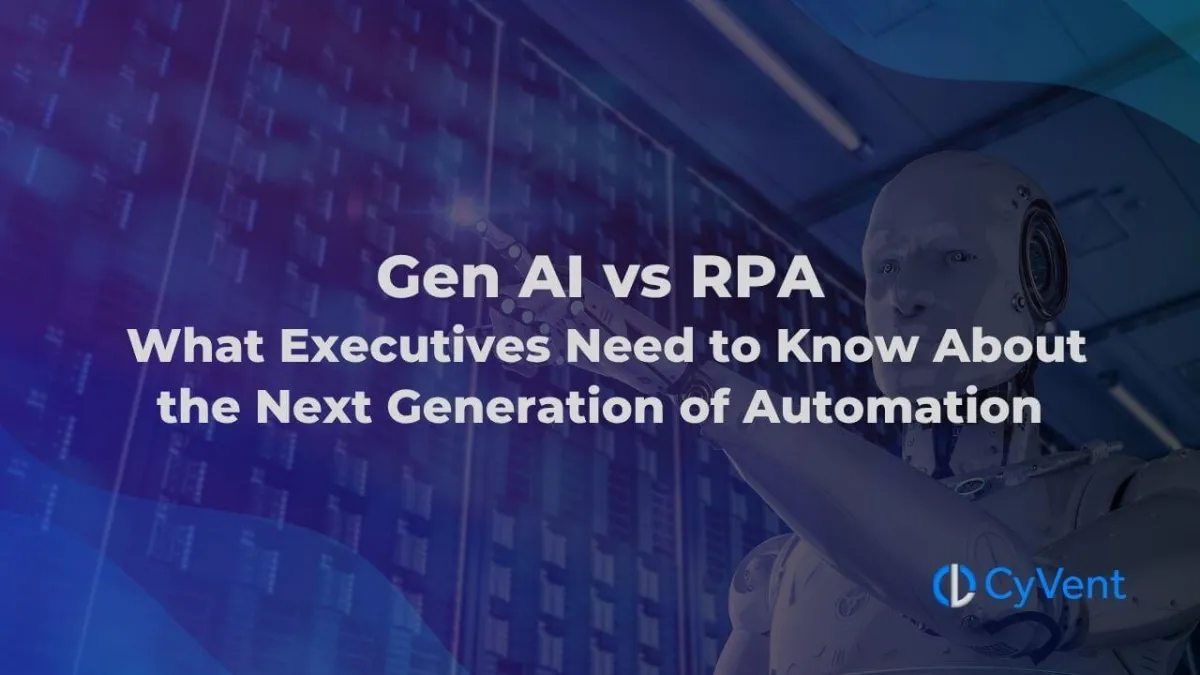
GenAI vs RPA: Key Automation Insights for Executives
By CyVent Team
Automation isn’t new - but what’s powering it is changing fast.
For over a decade, Robotic Process Automation (RPA) has helped businesses streamline repetitive, rules-based tasks. Repetitive processes, such as invoice processing, data entry, or employee onboarding, are ideal candidates for automation. Automating these tasks helps reduce human error, leading to greater accuracy and compliance. It’s predictable, reliable - and rigid. Software robots are the core of RPA, emulating human actions to automate these repetitive processes.
Then along came Generative AI (GenAI). GenAI is powered by artificial intelligence, bringing new cognitive capabilities to automation.
Suddenly, automation isn’t just about following instructions. It’s about understanding language, interpreting ambiguity, generating content, and making decisions based on dynamic context. That’s a different game entirely - and a big opportunity for forward-thinking leaders.
So, what do executives need to know right now?
RPA (Robotic Process Automation): The First Wave of Enterprise Automation

RPA works best in stable environments. It mimics human keystrokes, clicks, and logic-based workflows across applications. RPA interacts with various user interfaces to automate tasks across both modern and legacy systems. If the task is predictable and the process is clear, RPA is a cost-effective choice that can operate with legacy systems and existing systems, making it valuable for organizations with diverse technology stacks.
But here’s the challenge: Most real-world business processes aren’t that clean.
They involve unstructured data, changing rules, edge cases, and the need for human judgment. That’s where GenAI steps in.
GenAI (Generative AI): Context-Aware, Language-Native Automation

Generative AI brings something RPA can’t: flexibility. It can:
Summarize customer complaints and suggest a tailored response, powered by large language models that enable advanced understanding and generation of human-like text.
Extract insights from contracts, PDFs, or messy emails using natural language processing to interpret and analyze unstructured text.
Translate unstructured text into structured data, leveraging large language models for accurate and context-aware transformation.
Recommend next steps based on goals, tone, or history.
And it learns. GenAI models, built on machine learning and advanced machine learning models, improve with feedback, adapt to new use cases, and handle ambiguity in ways RPA can’t.
But GenAI isn’t a silver bullet either.
So, Should You Replace RPA With GenAI?

Not exactly. In most cases, GenAI augments RPA - not replaces it.
The smart move is combining both. Let RPA handle what it’s good at: repetitive, rule-based execution. Use GenAI where language, nuance, and variability come in. Together, they enable more end-to-end automation and reduce the need for manual intervention. This approach minimizes human intervention and enables organizations to automate tasks and automate processes more efficiently.
This blend is already reshaping workflows in:
Customer support: RPA initiates workflows, GenAI drafts responses
Legal ops: RPA moves files, GenAI extracts risk clauses
Finance: RPA reconciles data, GenAI analyzes anomalies
By integrating RPA robots, RPA software, and RPA tools with GenAI and AI tools, organizations achieve workflow automation, automated workflows, and business process automation across departments. These solutions streamline operations, improve accuracy, and enhance scalability.
This combination represents the next evolution of RPA technology and intelligent process automation, enabling more complex and adaptive automation solutions.
Key Considerations for Business Leaders and Executives

Start with the problem, not the tech
Map your highest-friction workflows. Consider the impact on the human workforce and human resources when planning automation initiatives. Where are employees wasting time? Where does handoff happen too often?Think hybrid, not wholesale
A combined approach - RPA + GenAI - usually delivers the best ROI. This empowers business users and enhances business operations by automating routine work.Don’t ignore governance
GenAI introduces new risks: hallucinations, compliance, data leakage. Guardrails, monitoring, and human-in-the-loop review are non-negotiable.Upskill your teams
Automation doesn’t replace your people - it upgrades them. Focus on training analysts, ops, and IT teams to partner with these tools effectively. Emphasize the importance of technical expertise and understanding software development concepts, even for non-developers, to maximize automation benefits.
Automation Governance: Ensuring Responsible and Compliant Automation

As organizations accelerate their digital transformation efforts with robotic process automation (RPA), strong automation governance becomes non-negotiable. Effective governance ensures that robotic process automation RPA is deployed responsibly, aligning with both business objectives and regulatory requirements.
Establishing clear policies, procedures, and standards is the foundation of successful RPA governance. This means setting guidelines for how RPA bots are developed, tested, and maintained, as well as defining roles and responsibilities for oversight. By doing so, organizations can ensure that their RPA implementations are consistent, secure, and scalable.
Ongoing monitoring and auditing of RPA systems are essential to prevent errors, data breaches, and other security threats. Proactive governance helps organizations identify and address risks before they escalate, protecting sensitive data and maintaining compliance with industry regulations.
Ultimately, robust automation governance not only minimizes risks but also maximizes the benefits of RPA—delivering greater efficiency, accuracy, and cost savings across business processes. With the right guardrails in place, organizations can confidently scale their automation technology and unlock new business opportunities.
Measuring Automation Effectiveness: Proving the Value of Your Investment

To justify continued investment in robotic process automation, executives need clear evidence of its impact. Measuring the effectiveness of RPA starts with tracking key performance indicators (KPIs) such as productivity gains, error reduction, and cost savings across business processes.
Financial metrics like return on investment (ROI), payback period, and net present value (NPV) provide a concrete view of the value delivered by robotic process automation RPA. But the story doesn’t end with numbers - organizations should also assess how RPA influences customer experience, employee satisfaction, and overall business process efficiency.
Regularly reviewing these metrics allows business leaders to identify what’s working, spot areas for improvement, and optimize their automation strategies. Transparent reporting on RPA effectiveness not only supports better decision-making but also helps build organizational buy-in for future automation initiatives.
By continuously measuring and communicating the value of RPA, organizations can ensure their automation technology delivers sustained benefits and drives meaningful digital transformation.
Employee Experience: Navigating Change and Empowering Your Workforce

Introducing robotic process automation RPA into your organization isn’t just a technical shift - it’s a people journey. The way you manage this change can make or break your automation success.
Effective change management starts with open communication. Help your teams understand how RPA will impact their daily work, the benefits it brings, and the new opportunities it creates. Providing targeted training and ongoing support ensures employees feel confident using new automation tools and adapting to evolving business processes.
Empowering your workforce means involving them in the RPA journey. Invite employees to contribute ideas for automation, participate in RPA development, and take advantage of upskilling and reskilling programs. Recognizing and rewarding their contributions fosters a culture of innovation and continuous improvement.
By prioritizing employee experience, organizations can minimize resistance, reduce the risk of job displacement, and boost morale. In fact, RPA can free up human workers from repetitive tasks, allowing them to focus on higher-value activities and creative problem-solving. This not only increases productivity and job satisfaction but also positions your business for long-term growth and success in the age of intelligent automation.
Final Takeaway: This Is the New Business Process Automation Stack

We’re moving from process automation to intelligent orchestration. That means shifting from:
“If this, then that” logic → to → “Understand, decide, act” agents
Rule-based scripts → to → Context-aware copilots
Manual data prep → to → AI-powered workflow orchestration. Modern automation now leverages data collection, input data, and computer vision to orchestrate workflows across digital systems.
Modern automation platforms use advanced software technology and software robotics to perform tasks, automate routine tasks, and handle high volume tasks efficiently across diverse underlying systems. These platforms enable seamless integration and automation without requiring changes to existing infrastructure, improving operational efficiency and accuracy.
The future isn’t RPA or GenAI. It’s both - working together to make your business faster, smarter, and more resilient. These technologies aim to augment human intelligence by enabling more adaptive and context-aware automation.
Ready to Modernize Your Automation Strategy?
CyVent helps forward-thinking businesses navigate the shift from legacy RPA to intelligent, GenAI-powered automation.
Want clarity on what to automate next - and how to do it securely?
👉 Book a strategy session with our team to explore where GenAI fits into your automation roadmap.


